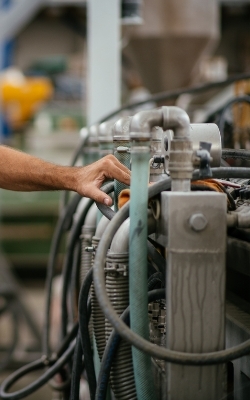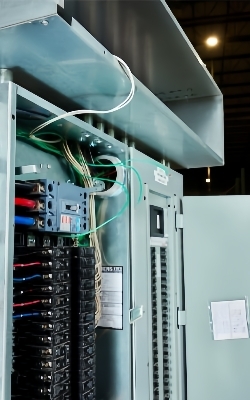The electrical phase rotation meter uses a 9V battery, which can be used for about one year, and the frequency range is 2Hz~400Hz. It uses a magnetic field measurement method with a high degree of precision and accuracy.

Accurate Detection
- Can detect motor line connection and motor rotation direction indication.
- Non-contact speed measurement method, safer measurement process.

Easy Operation
- LED intuitively displays phase/phase loss/reverse status.
- Double injection molded shell, double insulation protection, and CE standard compliance, better ensure user safety.
- There is an instruction table on the back for easy reference.
Applications
The application scenarios of phase sequence meters are very wide, covering multiple fields from basic power system debugging to complex industrial control systems. It has a wide range of applications in multiple fields. It not only ensures the correct operation of the equipment but also improves the safety and efficiency of the system. With the continuous advancement of technology, the functions of the phase sequence meter will be more diversified in the future, and its application in various fields will become more popular and important.

Equipment Maintenance

Factory Area

Teaching Experience

Electrician Field
| Model | SISCO-PRM-DT902 |
| AC Voltage | 120~400V |
| Test Frequency | 2~400Hz |
| Test Current | <3mA |
| Power Supply | 9V battery |
| Dimensions | 130mm×69mm×32mm |
| Working Temperature | 0~40℃ |
| Working humidity | 15%~80% |
| Pollution Degree | II |
| Protection Level | CATII1300V |
| Explosion Protection Type | IP40 |
| Weight | 130g |
Phase Sequence Status Description

- Display Symbol
- Phase Sequence is correct
- Reverse
- L1 phase is missing
- L2 phase is missing
- L3 phase is missing
Packaging List

- Host
- Alligator Clip
- Portable Cloth Bag
- Instruction Manual
- Test Lead
Q1: What factors can affect the phase rotation meter?
A1: The measurement accuracy and stability of the phase sequence meter may be affected by many factors. First, an unstable power supply or voltage that is too high or too low may cause deviations in the measurement results of the phase sequence meter. Secondly, circuit board aging, component damage, etc. may affect the normal operation of the phase sequence meter. In addition, sensor failure or damage will not be able to correctly detect the phase sequence information of the power supply. Of course, human errors in equipment settings or operating methods can also lead to measurement errors.
Q2: How does a phase rotation meter work?
A2: The working principle of the phase sequence meter is based on the detection and processing of three-phase voltage or current signals. It determines whether the phase sequence is correct by comparing the phase difference between the three-phase voltages. Common phase sequence detection algorithms include those based on zero-sequence detection and those based on positive and negative sequence components. When the phase sequence is correct, these algorithms will output corresponding signals to indicate that the phase sequence is correct; otherwise, they will indicate that the phase sequence is wrong.
Q3: What technical parameters should be paid attention to?
A3: The technical parameters of the phase sequence meter include but are not limited to input voltage range, power supply voltage, meter size, weight, ambient temperature, humidity, etc. These parameters are crucial for evaluating the performance and application scope of the phase sequence meter. In addition, the phase sequence meter must also have a certain insulation strength and anti-interference ability to adapt to different use environments and ensure the safety of operators.
Tips: How to choose a suitable phase sequence indicator?
Phase sequence meters are mainly divided into contact and non-contact types. The contact phase sequence meter requires the terminals of the three-phase wire to be opened and the three exposed clips or test pins of the phase sequence meter to be connected to the exposed live wire. The non-contact phase sequence meter uses a clamp-shaped non-contact inductive measurement to directly detect the phase sequence. The following factors should also be considered when choosing a suitable phase sequence meter:
- Determine the voltage and current range and frequency range that the phase sequence meter can measure according to the needs. Make sure that the measurement range of the selected instrument can cover the test object. Accuracy is also an important consideration, especially in applications with extremely high requirements for phase sequence.
- Different models of phase sequence meters have different functions. For example, some may only be used to measure phase sequence, while others may integrate multi-function measurements such as phase, frequency, voltage, and current.
- Physical characteristics, including size, weight, protection level, etc., need to be selected according to site conditions and usage environment.
Thank you for buying industrial test and measurement equipment on SISCO.com, all products sold by SISCO and the partner cover a 12 months warranty, effective from the date of receiving the products.
What is covered?
SISCO is responsible for providing free spare parts, and free technical support to assist the customer to repair the defective products until the problem is solved.
What is not covered?
- Product purchased from anyone other than a SISCO store or a SISCO authorized reseller.
- Expendable parts.
- Routine cleaning or normal cosmetic and mechanical wear.
- Damage from misuse, abuse or neglect.
- Damage from use of parts other than SISCO approved.
- Damage from use outside the product’s usage or storage parameters.
- Damage from use of parts not sold by SISCO.
- Damage from modification or incorporation into other products.
- Damage from repair or replacement of warranted parts by a service provider other than a SISCO authorized service provider.
- Damage caused by the application environment not meeting the product usage requirements and the failure to perform preventive maintenance.

